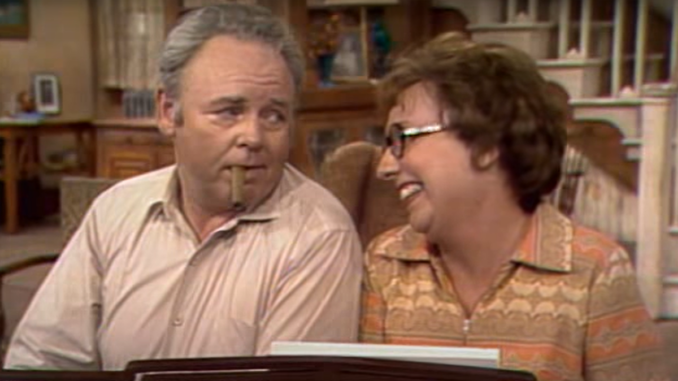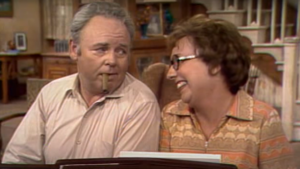
Introduction: In 1971, American television was shaken to its core. A new sitcom hit the airwaves that would do more than entertain—it would spark a revolution. All in the Family, created by Norman Lear, wasn’t just another show about quirky families or zany antics. It was a bold, fearless, and often controversial exploration of America’s most divisive issues. From racism to gender roles, from the Vietnam War to class inequality, All in the Family shattered the glass ceiling of what TV could—and should—address. It dared to tackle uncomfortable truths head-on, in ways no one had ever seen before.
Now, decades after its run, All in the Family remains one of the most important and groundbreaking television series in history. This is the story of how one show changed everything.
Breaking the Mold: The Fearless Approach That Shook America When All in the Family first aired, it didn’t just challenge the typical sitcom formula—it obliterated it. At a time when American television was filled with wholesome, sanitized depictions of family life, Lear’s creation was an unapologetic force of nature. The show starred Carroll O’Connor as Archie Bunker, the blue-collar patriarch who was as bigoted as he was lovable. Archie’s controversial views weren’t just fodder for laughs—they were a mirror to the prejudices that ran deep in American society.
In an era where television was often seen as “safe,” All in the Family was anything but. It ripped apart the facade of idealized family life, allowing viewers to confront uncomfortable subjects like racism, sexism, and class struggle. The show’s irreverent humor wasn’t just funny—it was a wake-up call. It forced America to look at itself, and not everyone was ready for that.
The show’s explosive success proved there was a demand for TV that took risks, that was willing to explore the gritty realities of the world in all its rawness. But All in the Family wasn’t just groundbreaking because it made people uncomfortable—it was groundbreaking because it made them think.
Meet the Characters That Changed TV Forever: Archie Bunker, the show’s central figure, was unlike any character audiences had seen before. He was a bigoted, working-class man who often clashed with his more progressive family members. His heated arguments with his son-in-law, Mike “Meathead” Stivic (played by Rob Reiner), became the heart of the show. These clashes between the older, conservative Archie and the younger, liberal Mike were more than just humorous—they were a reflection of the generational divides that defined the 1970s. The show didn’t shy away from the heated debates of the time, bringing issues like the Vietnam War, civil rights, and women’s liberation into the living room of every American household.
Archie’s wife, Edith, portrayed by Jean Stapleton, was the perfect foil to her husband’s fiery personality. Sweet, kind-hearted, and a bit naïve, Edith was the emotional anchor of the show. Despite Archie’s often cruel and unfair treatment of her, Edith’s resilience and unconditional love became a symbol of strength in the face of adversity. Her relationship with Archie was one of the most complex and beloved in TV history, showcasing the power dynamics within relationships while making audiences laugh and cry at the same time.
Then, there was Gloria Bunker-Stivic (played by Sally Struthers)—the fiery daughter of Archie and Edith, who often found herself caught between the ideological battles of her husband and father. Gloria was the representation of the feminist movement in the show, challenging her father’s sexist views and advocating for women’s rights in the midst of the social upheavals of the 70s. She was the voice of a new generation that was fighting for a seat at the table.
The Show That Sparked a Movement: But All in the Family didn’t just tackle sensitive subjects—it changed the way television could approach social issues. Before All in the Family, TV sitcoms rarely ventured into politically or socially charged topics. After its success, however, Lear became a pioneer of socially conscious programming, producing spin-offs like Maude, The Jeffersons, and Good Times, which further explored issues like race, gender, and class.
All in the Family didn’t just reflect America—it helped shape the way America viewed itself. It became a cultural phenomenon, making waves in the news, universities, and even the White House. President Richard Nixon publicly criticized the show, calling it “dangerous” and “un-American”—a testament to the impact it had on the national consciousness.
The show was a ratings juggernaut, finishing its run as one of the most-watched TV programs in the country. Its fearless approach to storytelling was a blueprint for future generations of creators, and its influence is still felt today in shows like The Simpsons, South Park, and Family Guy—all of which owe their edgy, political humor to the groundbreaking work done by All in the Family.

The Lasting Legacy: Despite its controversial nature, All in the Family remains beloved by fans and revered by critics. It’s one of the few TV shows whose relevance hasn’t faded with time. In an era where discussions of race, gender, and political correctness continue to dominate national debates, the show’s themes feel as timely and necessary as ever. All in the Family was more than just entertainment—it was a conversation starter, a cultural mirror, and a revolution in the making.
As we look back on its legacy, we see that All in the Family wasn’t just a show that got us to laugh—it was a show that got us to think. It made us confront the biases we often ignore and ask ourselves hard questions about our society. It remains a testament to the power of television to not just entertain, but to challenge, provoke, and ultimately change the world.
